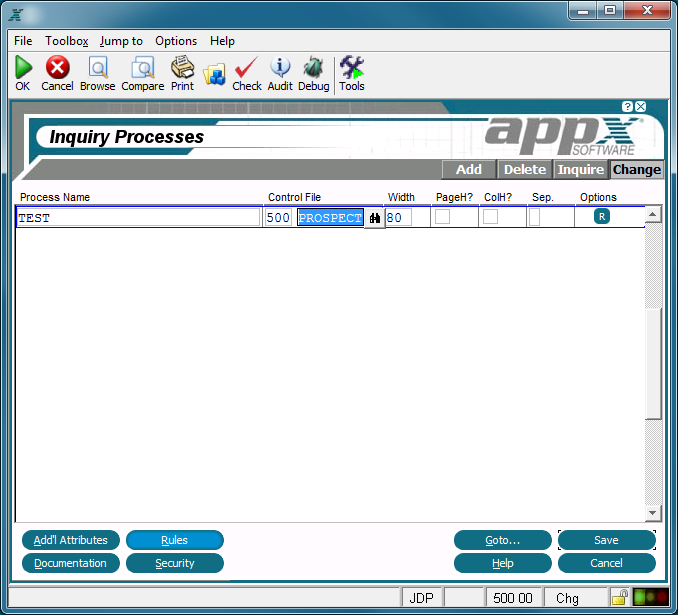Chapter 3-10: Inquiry Processes |
Inquiry Process Specifications Inquiry process specifications establish the general attributes of an inquiry process. They include such specifications as the inquiry print file, if any, the process control file, the name of the inquiry, and format characteristics. The Inquiry Processes screen is shown below.
Inquiry Processes Screen The Inquiry Processes screen contains the following inquiry-specific fields. Process Name identifies a specific process that is unique within type and application. Control File identifies a file by application ID and file name that is to be automatically managed by APPX during the execution of this process. APPX automatically reads the process control file (PCF) during inquiry process execution. Width indicates the maximum number of characters across, or in other words the number of columns, to allocate for each row in the report format. APPX uses the value you enter here to produce standard images of the proper width. If blank, the default width of the form that the report prints on defaults to the form width which is defined in system administration. If the form is narrower than the width of the formatted report, APPX truncates the inquiry. If the form is wider than the width of the report, however, APPX uses the larger width for standard images, but does not expand the format of the report itself. The default is 80.
PageH determines whether or not APPX automatically prints a page heading standard image. If 'yes'
ColH determines whether or not APPX automatically prints a Start of Page frame with a column heading standard image. APPX generates column headings based upon specifications in the data dictionary for each item included in the inquiry image. If 'yes' Sep (Separator) identifies one alphanumeric character that prints continuously across the report to separate standard page headings,page frames, and standard column headings from the body of the report. If blank, APPX does not print a heading separator. The default is =. Options are indicators that are present whenever documentation (T), rules (R), or additional attributes (AA) have been defined for this process. The following options as described in the corresponding sections are available on the Inquiry Processes screen: In addition, the menu bar provides the following pulldown menus: Toolbox - Same as the Process Toolbox Pulldown Menu. Jump to - Same as the Process Jump to Pulldown Menu. |
Application Design Manual "Powered by Appx Software"1106 ©2006 By APPX Software, Inc. All Rights Reserved |
